How to keep predators out of your pheasant pen
Wise keepers make life as difficult as possible for those pheasant pen predators intent on finding a tasty meal. Birds…
Win CENS ProFlex DX5 earplugs worth £1,149 – enter here
 Pheasant poult in the pheasant pen
Pheasant poult in the pheasant pen
My pheasant poults came yesterday, so by the time you read this they will have been here for a few weeks. The birds look good, all well-feathered and around seven weeks old. They are caught the night before from the rearing sheds and are delivered to me at around 4am, although they are seldom released before 5am. If it is still dark outside, the birds will struggle to walk out of the crates so it must be light enough.
The strain of these birds is a mix of pure bazanty and bazanty crosses, which always tend to hold, return, and fly well.
My usual routine for checking the birds has now commenced. For the next few weeks I will be making a mixture of checks at regular intervals during the day. Check, check, check and double-check. Within minutes after checking, the electric fence may short out or a drinker may leak the header tank onto the floor, so it’s best to be thorough and regular until they are bigger. Every morning, I fill up then move the feeders onto fresh ground and clean the drinkers out to help prevent disease.
I find 1,000 poults should eat between two and three bags of grower pellets a day. I can only drive around four of my six pheasant pens so two I have to walk around in the evening to double-check the electric fence, along with branches that may lay across it. I am a big believer in not walking around the pens too late in the evening, giving them plenty of time to settle once I have left. I have found that if you start walking around the pens when the majority of birds are up to roost, they are more likely to spook and flush over the wire, doing more harm than good.
Wise keepers make life as difficult as possible for those pheasant pen predators intent on finding a tasty meal. Birds…
One evening that really sticks in my mind is a ratting session with my friend Kev Hawker in February. As…
It always seems to be the same areas that attract the problem foxes, year after year. I have been lamping on and off for the past few weeks without seeing many, but as soon as the birds arrive the foxes come out from hiding. I tend to sit out by a pen in the early evening with a thermal spotter and NV scope on my .223 and wait for the foxes to come out. The poults last night were easily spooked as they were in an unknown area. The foxes learn to keep far enough from the electric fence to be able to spook the birds enough to make them fly out of the pen for them to hunt. I watched this begin to happen on three of my pens last night but managed to put a stop to it fairly swiftly for one evening. It is one reason I prefer to top as much cover around the pen perimeter as possible, as foxes are more likely to pounce on the pheasant poults that jug up in long grass than in open fields.
Trying to improve the husbandry of the birds in the release pens is an important part of my work. The habitat in the pens has been improved since I became gamekeeper on this estate but there are other factors that can aid the proficiency of the growing poults. With the strong emphasis on reducing antibiotic use in the industry, I have been researching how I can prevent disease outbreaks from occurring using other methods.
I have always used Quill Boost Tonic in the water for the first few weeks when the birds arrive – to help to improve their gut health and give them a boost at one of the most stressful times in a poult’s lifetime.
Any modifications you perform are best derived from the advice of a gamebird vet. After researching and speaking to various vets and keepers to ask for their thoughts on the matter, the consensus has been similar. Increasing the acidity of the water provided to the birds can aid in the prevention of bacterial growth, which generally prefer an alkaline environment to proliferate.
With this in mind, I purchased a pH tester to test the water in each pen. We are fed from a borehole here, and the water is extremely hard, creating an abundance of limescale. The pH has been near eight in most of the pens, showing its high alkaline properties, which will need to be taken into account when administering the tonic. The water systems have been flushed out with water cleaner called Intra Hydrocare before having the boost added. Using ultimate acids, or even apple cider vinegar, can perform a similar task. With the ever-fluctuating weather conditions and predation pressures, any extra precautions I can put into place will be beneficial.
Get the latest news delivered direct to your door
Discover the ultimate companion for field sports enthusiasts with Shooting Times & Country Magazine, the UK’s leading weekly publication that has been at the forefront of shooting culture since 1882. Subscribers gain access to expert tips, comprehensive gear reviews, seasonal advice and a vibrant community of like-minded shooters.
Save on shop price when you subscribe with weekly issues featuring in-depth articles on gundog training, exclusive member offers and access to the digital back issue library. A Shooting Times & Country subscription is more than a magazine, don’t just read about the countryside; immerse yourself in its most authoritative and engaging publication.

